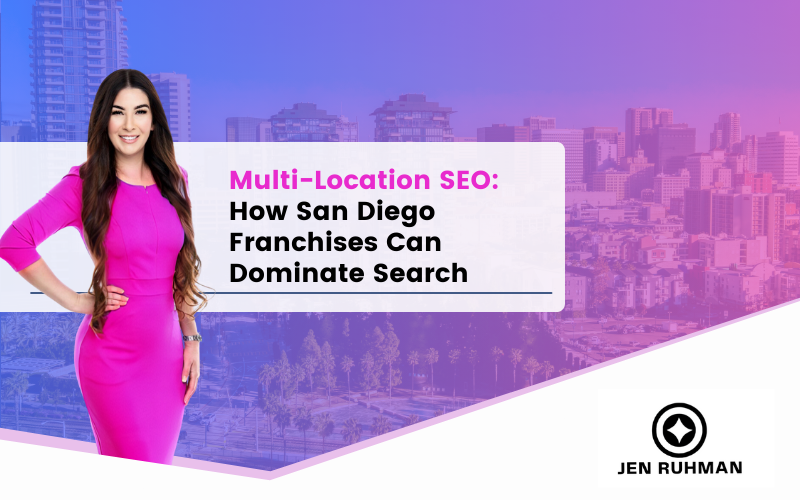Multi-Location SEO: How San Diego Franchises Can Dominate Search (From Jen Ruhman)
To dominate multi-location SEO in San Diego, give each location its own Google Business Profile, a unique, content-rich location page, and a consistent NAP footprint across trusted local entities (think: San Diego Chamber, BBB, neighborhood associations). Layer in review velocity, local backlinks, location-specific schema, and internal links from city hubs to neighborhood pages. Keep answers snippet-ready for AI Overviews (SGE) and track wins with call tracking + GBP Insights. If you need help, I’m an SEO expert in San Diego and I’ve scaled this playbook for franchises across the county. Call/text me: (619) 719-1315.
Why Listen to Me (E-E-A-T in Plain English)
I’m Jen Ruhman, owner of a proven SEO company San Diego businesses trust. Over the years I’ve audited and rebuilt multi-location SEO frameworks for franchises from Chula Vista to Oceanside. My hands-on approach (site architecture, GBP ops, review systems, and entity building) consistently improves map pack visibility and organic leads—without gimmicks.
What Multi-Location SEO Actually Means
Multi-location SEO is the strategy that helps customers find the right storefront or service area page for their closest location. It’s not just “duplicate the same page and swap the city.” It’s:
A scalable site architecture
Unique location pages with real local proof
GBP mastery for each address
Entity-based signals that tie your brand to the neighborhoods you serve
Reviews, local links, and accurate citations
Franchise vs. multi-branch vs. service-area
Franchise: Different owners/operators under the same brand; governance and consistency matter.
Multi-branch: Corporate-owned locations; centralized management helps standardize data.
Service-area: Field teams (e.g., HVAC) that may or may not have storefronts; must build strong city hubs.
The San Diego Entity Stack (Local Signals You Can Control)
Entity SEO is about verifiable connections. In San Diego, that means aligning your locations with recognizable local entities.
Neighborhood & landmark entities
Reference and serve content around real areas like Gaslamp Quarter, La Jolla, Hillcrest, North Park, Mission Valley, Kearny Mesa, Clairemont, Encinitas, Carlsbad, Escondido, Chula Vista, and landmarks like Balboa Park, Petco Park, UC San Diego, and San Diego Convention Center. Use these naturally in your copy, photos, alt text, and GBP posts.
NAP and official records
Keep Name, Address, Phone identical across GBP, Apple Maps, Bing Places, Yelp, BBB, and San Diego Chamber of Commerce listings.
Match what appears in city business licenses or county records where applicable.
Use location-level tracking numbers but don’t replace the main number in NAP fields on authoritative listings.
Site Architecture That Scales
Your website should make it obvious to users (and crawlers) where each location lives.
Hub-and-spoke model
/locations/ = hub page with a county map module and all branches.
/locations/san-diego/ = city hub linking to neighborhoods (if you serve a big city).
/locations/san-diego/hillcrest/ = neighborhood spoke (optional for dense metros).
/locations/chula-vista/, /locations/oceanside/, etc., for each branch.
Internal linking rules
From the homepage and service pages, link to the nearest hub and top-performing locations.
Cross-link sibling locations via a “Near You” widget (e.g., “Also serving Mission Valley and Kearny Mesa”).
Use descriptive anchors (e.g., “San Diego carpet cleaning in Hillcrest”).
Location Pages That Truly Earn Rankings
Cookie-cutter pages die in competitive markets. Each page must feel like a local micro-homepage.
A reusable page template
H1: Service + City (e.g., “Premium Window Cleaning in La Jolla”)
Intro: One-paragraph value prop with neighborhood references
Services: Location-specific service mix, pricing ranges or “from” pricing
Proof: Photos from this location, staff names, local testimonials
Map & parking: Embedded map, parking tips (Mission Valley vs. street parking in North Park)
Local FAQs: Based on real queries from that area
Schema: LocalBusiness (location-specific), FAQPage
CTAs: Click-to-call, request a quote, hours today
On-page checklist (titles, headers, schema)
Title: Primary service + city + brand (keep under ~60 chars when possible)
H2s/H3s: Include neighborhood entities where natural
FAQPage schema: Direct, short answers to common questions
Images: Real photos geotagged at creation time (don’t overdo EXIF), named with city
Google Business Profile (GBP) for Every Location
Your GBP is your map pack engine. Treat each as a local storefront on Google.
Categories, services, products & photos
Use the most specific primary category; add supporting secondaries.
Fill Services with the same language as the location page.
Upload team photos, interior/exterior shots, and work-in-progress galleries frequently.
Posts, Q&A, and review prompts
Post 2–4x per month per location: promos, before/afters, neighborhood tips.
Seed Q&A with real questions (“Do you service condos near Petco Park?”).
Automate review requests (via email/SMS) within 24 hours of service; respond to every review with local context.
Reviews & Reputation Flywheel
Create a review “ask” script your staff can use (“We serve a lot of Hillcrest residents—your review helps neighbors find us.”).
Rotate your review links to balance profiles (GBP, Yelp where allowed, niche sites).
Track review velocity and ratings mix per location; coach under-performing teams.
Local Content That Moves the Needle
Beyond location pages, publish content that proves local expertise:
Neighborhood guides: “Home Cleaning Tips for La Jolla’s Coastal Homes”
Event support: “Traffic & Parking Guide for Padres Game Days near Gaslamp”
Partnerships: Co-authored posts with San Diego nonprofits, neighborhood associations, or local chambers
How-to content: Answer seasonal queries (e.g., “Allergy season cleaning tips in North Park”)
Pro tip: Interlink these posts to specific location pages, not just your blog hub.
Citations & Local Links Without the Spam
Focus on trust over volume:
San Diego Chamber of Commerce, Better Business Bureau (San Diego), Local First groups, city/neighborhood business associations
Sponsorships with youth sports, community clean-ups, or arts festivals
Thoughtful outreach to local blogs and newsletters that actually cover your neighborhoods
AI Overviews (SGE) Optimization
AI Overviews reward clear, structured answers and verified entities.
Add FAQ blocks on every location page (with FAQPage schema).
Use definition-style intros and step lists where appropriate.
Keep answers short and factual; then expand in the body copy.
Maintain consistent entity names (company, locations, neighborhoods) site-wide.
Tracking What Matters
Call tracking numbers per location (use in CTAs; keep your main NAP number stable where required).
GBP Insights: Monitor calls, direction requests, and views per profile.
UTM tags on GBP website buttons and posts.
Location-level goals in GA4 (form submits, phone clicks, map clicks).
Common Pitfalls I See in Franchise Audits
Duplicate pages with only city swapped
One GBP representing multiple addresses (violates guidelines)
Thin content (no real photos, no local proof)
Inconsistent NAP across directories
No internal link strategy (or wrong anchors)
No review system, so competitors outrun you in social proof
Mini Case Snapshot (San Diego Franchise)
A franchise owner with locations in Kearny Mesa, Mission Valley, and Chula Vista came to me with flat map pack visibility. We rebuilt the site architecture, launched new location pages with real staff photos and local FAQs, cleaned up citations, and rolled out review prompts. Within a few months, the locations began appearing more often for neighborhood + service terms—especially where we added event-based posts (e.g., game day traffic guides) and better internal links from the city hub. Results vary, but the pattern is consistent: structure + proof wins.
Your 30-Day Action Plan
Week 1–2
Audit GBP per location (categories, services, photos, Q&A)
Map site architecture and create a /locations/ hub
Draft location page template and build 2–3 priority pages
Week 3
Launch review system and staff scripts
Submit/clean key citations (Chamber, BBB, Apple Maps, Bing Places)
Publish two local guides tied to neighborhoods
Week 4
Add FAQ blocks and FAQ schema to all new pages
Wire call tracking + UTM rules
Build internal links from home, services, and blog to location pages with descriptive anchors
Need a partner to run this playbook end-to-end? I’m an SEO expert in San Diego who does this every day.
Call/Text Me — Let’s Build Your Local Moat
If you want a seasoned SEO company San Diego franchises trust, I’m here to help. I’ll audit your locations, fix the foundations, and roll out a scalable plan that earns rankings and phone calls. Call/text me at (619) 719-1315 or reach out through my site to get started.
Winning multi-location SEO in San Diego isn’t about shortcuts; it’s about structure, proof, and local relevance. With the right architecture, GBP execution, entity signals, and review momentum, your franchise can own both the map pack and organic results—from La Jolla to Chula Vista. Keep your answers clear for AI Overviews, give each location its own voice, and measure what matters. When you’re ready for experienced hands, I’m a local call away.
FAQs
1) How many Google Business Profiles should my franchise have?
One per eligible physical location that serves customers—each with its own address, hours, and phone (tracking number okay in CTAs; keep NAP consistent on listings).
2) Do I need unique content for every location page?
Yes. Reuse the template, but include local photos, staff names, neighborhood references, FAQs, and testimonials per location.
3) Can service-area businesses win without storefronts?
Absolutely. Build city hubs, target service clusters, and lean on local partnerships, reviews, and FAQ schema.
4) What’s the fastest win for multi-location SEO?
Fix GBP categories and services, add real photos, and start a review request system. These moves often drive quick visibility wins.
5) How do I track ROI across locations?
Use call tracking, UTM standards, GBP Insights, and GA4 goals by location. Compare apples to apples monthly.


